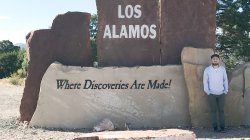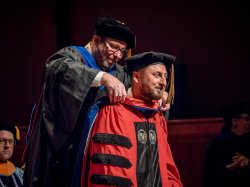From Montclair State to Los Alamos
Garrett Nieddu is taking his PhD across the country to the Los Alamos National Lab where he will study the viral dynamics of infection and the role of the immune response for the influenza A virus and human immunodeficiency virus.
Posted in: Program Alumni

Dr. Garrett Nieddu arrived at Montclair State University in 2008 with an Associate’s degree from Ocean County College. Two years later he graduated with a BS degree in both Mathematics and Physics. Inspired by the undergraduate research he did with mentoring from Dr. Mary Lou West (Professor Emeritus, Department of Physics and Astronomy), he decided to continue his education. In 2012 Dr. Nieddu graduated with an MS degree in Mathematics. Advised by Dr. David Trubatch (Department of Mathematical Sciences), his MS thesis involved a study of thermalization and initial-state recurrence in a system whose genesis is a classical problem known as the Fermi, Pasta, and Ulam (FPU) problem. With a solid background in mathematics and physics, and with broad interest in economics, politics, and environmental sustainability, Dr. Nieddu decided to stay at Montclair State to pursue a PhD in the interdisciplinary Environmental Management program.

- the contribution of non-zero steady-state cycling to the longevity of a population with multiple metastable states
- determined the optimal path to disease extinction in a stochastic Ebola virus disease (EVD) model and developed a method to indicate outbreak vulnerability when the EVD-population is weakly coupled to the disease reservoir
- generalized the concept of outbreak vulnerability beyond weakly coupled systems so that one can identify a practical barrier in parameter space that divides the region into ‘weak/strong coupling’ and a ‘fully connected zone’ for which the two populations in question cannot be said to be separate sub-populations.
Graduating with his doctorate in 2018, Dr. Nieddu has now moved to New Mexico where he is a Postdoctoral Research Associate in the T-6 Theoretical Biology and Biophysics Division at Los Alamos National Laboratory studying the viral dynamics of infection and the role of the immune response for the influenza A virus and human immunodeficiency virus. The influenza A virus (IAV) and human immunodeficiency virus (HIV) are important human pathogens, responsible for millions of human deaths each year. Both pathogens pose significant challenges to the development of effective therapeutics. At Los Alamos National Lab, Dr. Nieddu uses stochastic modeling methods to help understand viral dynamics of infection, and the role of the immune response in persistent infections. The results will be used to guide the development of effective therapies for IAV and HIV. This will be accomplished through close work with experimentalists; the model results will be used to guide the experiments, and the experimental results will be used to inform (and improve) the models.
There exist enormous genetic and genomic diversity for IAV within a host. These diversities drive IAV’s incredible ability to adapt, evolve, and ultimately abate vaccine efficacy. Most viral particles, however, are not capable of reproducing alone. These semi-infectious particles (SIPS), need other SIPS –and the infrastructure of a viable cell– in order to reproduce. Fully infectious particles (FIPS) comprise less than 10% of the viral population. Alongside these infectious particles are the innocuous defective interfering particles (DIPS), which cannot reproduce, and actually compete with SIPS and FIPS for reproduction resources. An understanding of the interactions between these particles is key to developing effective therapies. However, very little is understood about the specific viral dynamics. Mixing experimentation with mathematical modeling can help us to better understand the biology, and therefore develop prevention and treatment strategies.
HIV poses very different challenges. Combination antiretroviral treatments (cARTs) effectively suppress viral load; however, it does not eradicate the virus due to the existence of the latent reservoir. Recently, clinical trials show that a small fraction of patients achieve post-treatment control (PTC) after cART, although all patients do eventually experience viral rebound. However, the factors determining PTC vs. viral rebound, such as the viral diversity in the reservoir and the heterogeneity in the immune response, are still not clear. There is quite a bit of variation in rebound times among patients, and it is believed that viral rebound is a stochastic process. To that end, Dr. Nieddu is building and analyzing an in-host model, capable of displaying viral rebound after long periods of post-treatment control.
Congratulations to Dr. Nieddu on his new position! We wish him well as he continues his career, and look forward to hearing about his wonderful accomplishments.
